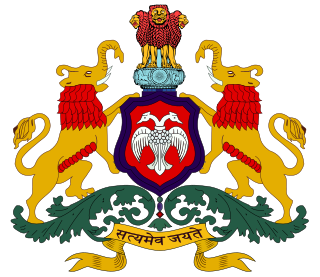Related Research Articles

Local government is a generic term for the lowest tiers of governance or public administration within a particular sovereign state.

India is a federal republic comprising 28 states and 8 union territories. The states and union territories are further subdivided into districts and smaller administrative divisions.
The Indian Republic held its first elections in 1951–52.
A capital district, capital region, or capital territory is normally a specially designated administrative division where a country's seat of government is located. As such, in a federal model of government, no state or territory has any political or economic advantage relative to the others because of the national capital lying within its borders. A capital territory can be a specific form of federal district.
The administrative divisions of India are subnational administrative units of India; they are composed of a nested hierarchy of administrative divisions.

The Government of Karnataka, abbreviated as GoK, or simply Karnataka Government, formerly Government of Mysore, is a democratically elected state body with the governor as the ceremonial head to govern the Southwest Indian state of Karnataka. The governor who is appointed for five years appoints the chief minister and on the advice of the chief minister appoints his council of ministers. Even though the governor remains the ceremonial head of the state, the day-to-day running of the government is taken care of by the chief minister and his council of ministers in whom a great amount of legislative powers are vested.

The Puducherry Legislative Assembly is the unicameral legislature of the Indian union territory (UT) of Puducherry, which comprises four districts: Puducherry, Karaikal, Mahé and Yanam. Out of eight union territories of India, only three have legislatures and they are Delhi, Puducherry and Jammu and Kashmir. After delimitation shortly after its formation, the Puducherry legislative assembly has 33 seats, of which 5 are reserved for candidates from scheduled castes and 3 members are nominated by the Government of India. 30 out of 33 Members are elected directly by the people on the basis of universal adult franchise and the remaining three are nominated by the central government. These nominated members enjoy same powers as elected members of the assembly.

Pakistan is a federal republic with three tiers of government: national, provincial and local. Local government is protected by the constitution in Articles 32 and 140-A, and each province also has its own local-government-enabling legislation and ministries responsible for implementation. District councils and metropolitan corporations are respectively the highest rural and urban tiers of local government in the provinces. Both urban and rural local government have two or three tiers in all provinces except Khyber Pakhtunkhwa, where councils are not identified as either urban or rural. There are 129 district councils across the four provinces, 619 urban councils made up of one city district, four metropolitan corporations, 13 municipal corporations, 96 municipal committees, 148 town councils, 360 urban union committees, and 1,925 rural councils. Additionally there are 3339 neighbourhood, ‘tehsil’ and village councils in Khyber Pakhtunkhwa.
The Government of Delhi, officially the Government of the National Capital Territory of Delhi (GNCTD) is the governing body of the Union Territory of Delhi, whose urban area is the seat of the Government of India. It also governs the city or local governments in the area as per the 74th Constitutional Amendment Act.

A union territory is a type of administrative division in the Republic of India. Unlike the states of India, which have their own governments, union territories are federal territories governed, in part or in whole, by the Union Government of India. There are currently eight union territories in India: Andaman and Nicobar Islands, Chandigarh, Dadra and Nagar Haveli and Daman and Diu, Delhi, Jammu and Kashmir, Ladakh, Lakshadweep and Puducherry.

The Government of Jammu and Kashmir is the governing authority of the Indian union territory of Jammu and Kashmir and its two divisions and 20 districts.
The Jammu and Kashmir Legislative Assembly, also known as the Jammu and Kashmir Vidhan Sabha is the legislature of Indian union territory of Jammu and Kashmir.

The Jammu and Kashmir Legislative Council was the upper house of the legislature of the erstwhile state of Jammu and Kashmir, India.

The States Reorganisation Act, 1956 was a major reform of the boundaries of India's states and territories, organising them along linguistic lines.

The first Delhi Legislative Assembly election to the Delhi Legislative Assembly was held on 27 March 1952. Forty-eight seats were up for election. Six of the constituencies elected two assembly members, the remaining 36 constituencies elected a single member.

The Delhi Legislative Assembly, also known as the Delhi Vidhan Sabha, is a unicameral legislature of the union territory of Delhi in India. Delhi Legislative Assembly is the legislative arm of the Government of Delhi. At present, it consists of 70 members, directly elected from 70 constituencies. The tenure of the Legislative Assembly is five years unless dissolved sooner.

Government of NCT of Delhi versus Union of India & Another [C. A. No. 2357 of 2017] is a civil appeal heard before the Supreme Court of India by a five-judge constitution bench of the court. The case was filed as an appeal to an August 2016 verdict of the Delhi High Court that ruled that the lieutenant governor of Delhi exercised "complete control of all matters regarding National Capital Territory (NCT) of Delhi", and was heard by the Supreme Court in November and December 2017.

The Administration of Union Territory of Ladakh(sic) is the governing authority of the Indian union territory of Ladakh and its two districts. The Administration is led by a Lieutenant Governor appointed by the President of India who acts on behalf of the central Government of India. Ladakh does not have an elected legislative assembly. The two districts of Ladakh both elect their own autonomous district council-the Leh Autonomous Hill development council and the Kargil Autonomous Hill development Council, which have competence over a range of domestic affairs.
The first elections for the Delhi Metropolitan Council were held in Indian National Capital Territory of Delhi in February 1967. L. K. Advani of the Bharatiya Jana Sangh was sworn in as the Chairman of the Council.
References
- ↑ Atul Mathur (7 December 2011). "The making of a capital state". hindustantimes.com. Hindustan Times . Retrieved 4 August 2020.
- 1 2 "History of Delhi Legislative Assembly". Legislative Assembly of Delhi website.
- ↑ "Delhi Metropolitan Council(1966–1990)". Delhi Legislative Assembly. Retrieved 22 January 2014.
- ↑ "Delhi Metropolitan Council (1966-1990)". delhiassembly.nic.in.
- ↑ Coomi Kappor (28 February 1983). "Delhi civic polls: Congress(I) fights back, wins an impressive victory". indiatoday.in/magazine. New Delhi: India Today . Retrieved 5 August 2020.